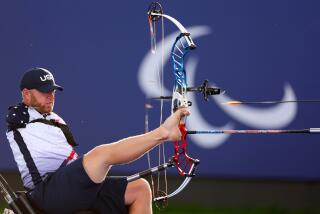Athletes Wheelchair : ‘Fighters and Adapters’ Roll Out in Lightweight, Easy-to-Repair, Bright Chairs Designed for Sports
- Share via
For Mike Dempsey, the traditional wheelchair evokes a sense of severe limitation and exclusion from able-bodied society.
Dempsey, the 33-year-old president of the Camarillo-based Kuschall of America, is determined to change that. The company manufactures and markets what Dempsey refers to as “high-end, ultralight wheelchairs.” Different from the traditional wheelchair in both function and appearance, these chairs play a significant role in increasing the activities of wheelchair athletes, he says.
Dempsey, who refers to himself and other wheelchair athletes as “fighters and adapters,” has been a paraplegic since infancy. “A doctor gave me the wrong spinal injection,” he says, “and that was it.”
But Dempsey’s disability couldn’t keep him out of sports. The world champion paraplegic table tennis player at the Seoul Olympics, Dempsey is also among the hundred best players in this country--able or disabled. And the National Wheelchair Athletic Assn. named Dempsey “Male Athlete of the Year” for 1989.
Several years ago, Dempsey’s interest in wheelchair athletics led to a meeting with Rainier Kuschall, a Swiss quadriplegic who designed the original chair on which Dempsey’s Champion line is based. Shortly afterward, Dempsey obtained a licensing agreement from the Kuschall Co. in Basel, Switzerland, and began manufacturing and marketing the chairs in this country. Since then, the company has quadrupled its sales and the chairs are being sold by 400 dealers nationwide.
Among a dozen companies that produce similar chairs, Kuschall is second only to Motion Designs, a Fresno-based company. Dempsey calls his company “the Avis of the ultralight chairs.”
Designed for use by athletes and non-athletes, these chairs differ from traditional wheelchairs in several ways. Constructed of aluminum tubing or high-grade plastic, the Champion chairs weigh 17 and 30 pounds; traditional wheelchairs, made of chrome-plated steel, weigh between 45 and 60 pounds. In addition, the lightweight chairs are easily adjusted and repaired. In a striking departure from the dull hues of the traditional chairs, the Champion chairs come in 11 bright colors.
As a tribute to its unique design, the Champion 3000 chair was included by the Museum of Modern Art in New York City in a 1988 exhibition entitled “Designs For Independent Living.”.
The chairs, which sell for between $1,500 and $1,600, accommodate the idiosyncrasies of each sport. For table tennis players, the chair has a lower back so it doesn’t interfere with the swing, an armrest on the player’s non-racquet side and brakes to eliminate unnecessary movement and allow for a quicker response. Other adaptations are made to suit the needs of each sport and each owner.
One such owner is Darrel Ray, a Los Angeles film and television writer who has worked on shows such as “Hill Street Blues.” Ray, a marathon racer and self-defined “fussy wheelchair person,” also plays rugby. For him, the most important feature of these chairs is the ease with which they can be repaired. Ray does minor repairs himself. This feature plus the chair’s portability allows him to be independent.
For Ray, comparing such lightweight chairs to traditional wheelchairs is “like comparing running shoes to combat boots.”
For another user, Bob Malinotti, who came in second in the wheelchair component of the Los Angeles Marathon, the aesthetic appeal of the chairs is foremost.
Both men agree with Paul De Pace, president of the National Wheelchair Athletic Assn. De Pace cannot endorse any particular make or model, but he is an avid proponent of lightweight chairs. Injured in an auto accident 20 years ago, De Pace recalls his difficulty in handling a 55-pound wheelchair.
“The public sees wheelchairs as things that users sit on,” he says, “but they are really prosthetic devices--extensions of the user. The lighter and the more aesthetically pleasing they are, the easier the entire experience.”
More to Read
Go beyond the scoreboard
Get the latest on L.A.'s teams in the daily Sports Report newsletter.
You may occasionally receive promotional content from the Los Angeles Times.










